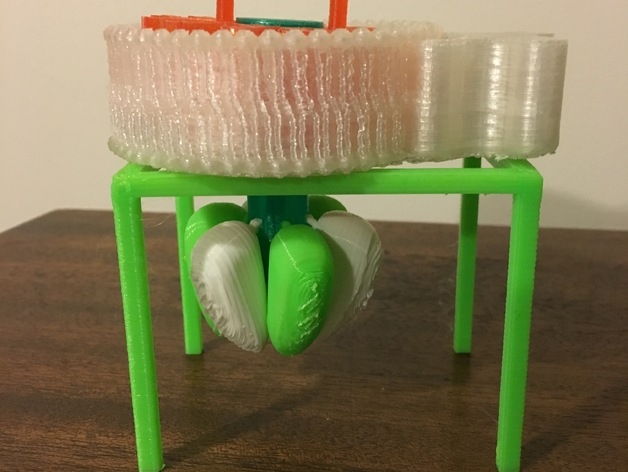
ATP Synthase
myminifactory
This model of ATP Synthase (ATPase) lets students delve into how a proton concentration gradient is utilized to store energy in the form of ATP. Protons are inserted into the protein through the opening on the topside of the membrane. The protons move into the c-subunit, where each added proton causes the c-subunit to rotate. Eventually, the proton drops out the bottom of the membrane as the c-subunit continues spinning. As the c-subunit rotates, the alpha and beta subunits move, simulating the conformational changes required for the protein to combine ADP and Pi to form ATP. Also included is an actin filament, which was used in the experiment that first demonstrated the spinning motion of ATP synthase. It would be fascinating to use a glow-in-the-dark filament to print this part of the model, then recreate the experiment using a UV light. Understanding the function of proteins is a crucial aspect of a biology course. Specifically, students must grasp the relationship between structure and function of biological molecules. This model of ATP synthase allows students to see how the structure of ATP synthase enables it to produce ATP molecules in the electron transport chain. The model should be used after students have been taught about the structures of proteins. Students should also be familiar with the process of cellular respiration, specifically the electron transport chain in the mitochondria, ions, concentration, and diffusion. Before using the model, ensure students understand how energy is stored in a concentration gradient and how a hydrogen ion concentration is built up in the mitochondria. Describe how the small balls represent protons and ask students what will happen if most of the protons are located on the upper side of the membrane. Students can use the model to explore where these ions can go and how the c-subunit can spin to move the protons through the membrane. Students should notice how the spinning of the c-subunit causes the lower section of the protein to move. Describe how the energy of this movement is used to combine ADP and Pi to form ATP. The discovery of the way ATPase moves can be re-enacted by using a fluorescent actin filament. Students can either design an experiment or follow through on how the experiment was done. A fluorescent tag was added so that scientists could measure the position with a camera (use glow-in-the-dark filament for the actin filament and a UV light if possible). Objectives Students will be able to describe how energy in a concentration gradient is transferred into the molecule ATP. Students will be able to label and describe the functions of the different subunits of the ATP synthase protein. Students will be able to describe the process by which the body creates ATP. Students will be able to describe the experiment and data used to show that ATP is a spinning protein, working much like a hydroelectric generator. Students will be able to describe the technique of fluorescence. Results Students should be able to describe the process by which energy in a concentration gradient is converted into the chemical energy of ATP. The model serves as a starting point for further discussion into the subunits and structure of this and other proteins. Students can research the mechanisms by which ATP is formed on the chemical level, as well as the effects of toxins, drugs, and diseases on these proteins.
With this file you will be able to print ATP Synthase with your 3D printer. Click on the button and save the file on your computer to work, edit or customize your design. You can also find more 3D designs for printers on ATP Synthase.
